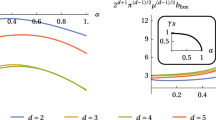Abstract
Continuous data dependence estimates are employed to rigorously derive conditions that validate the quasi-static approximation for the initial homogeneous boundary value problem in the theory of small elastic deformations superposed upon large elastic deformations. This theory imposes no sign-definite assumptions on the linearised elastic moduli and in consequence the requisite estimates are established using methods principally motivated by known Lagrange identity arguments.
Similar content being viewed by others
References
Boley BA, Weiner JK (1960) Theory of thermal stresses. Wiley, New York
Duhamel JMC (1837) Second mémoire sur les phénomènes thermo-mecaniques. J de l’École Polytech 15:1–57
Quintanilla R (2004) Spatial stability for the quasi-static problem of thermoelasticity. J Elast 76:93–105
Gilchrist MD, Rashid B, Murphy JG, Saccomandi JG (2013) Quasi-static deformations of biological soft tissue. Math Mech Solids 18:622–633
Pucci E, Saccomandi G (2010) On a special class of nonlinear viscoelastic solids. Math Mech Solids 15:803–811
Pucci E, Saccomandi G (2012) On the nonlinear theory of viscoelasticity of differential type. Math Mech Solids 17:624–630
Dafermos CM (1968) On the existence and the asymptotic stability of solutions to the equations of linear thermoelasticity. Arch Ration Mech Anal 29:241–271
Dafermos CM (1976) Contraction semigroups and trend to equilibrium in continuum mechanics. Lectures notes in mathematics, vol 503. Springer, Berlin, pp 295–306
Lebau G, Zuazua E (1999) Decay rates for the three-dimensional linear system of thermoelasticity. Arch Ration Mech Anal 148:179–231
Day WA (1981) Justification of the uncoupled quasi-static approximation in the problem of dynamic thermoelasticity. Arch Ration Mech Anal 77:387–396
Day WA (1982) Further justification of the uncoupled quasi-static approximations in thermoelasticity. Arch Ration Mech Anal 79:85–95
Esham BF, Weinacht RJ (1994) Singular perturbations and the coupled/quasi-static approximation in linear thermoelasticity. SIAM J Math Anal 25:1521–1536
Esham BF, Weinacht RJ (1999) Limitation of the coupled/quasi-static approximation in multidimensional linear thermoelasticity. Appl Anal 73:72–87
Knops RJ, Quintanilla R (2018) Quasi-static approximations in linear thermoelastodynamics. J Thermal Stress 41:1432–1449
Ames KA, Straughan B (1999) Non-standard and improperly posed problems. Mathematics in science and engineering, vol 194. Academic Press, San Diego
Brun L (1969) Méthodes énergetiques dans les systemes évolutifs linéaires. Deuxieme Partie: Théorèmes d’ unicité. J de Méchanique 8:167–192
Chirita S, Rionero S (1987) The Lagrange identity method in linear thermoelasticity. Int J Eng Sci 25:935–947
Flavin JN, Rionero S (1996) Qualitative estimates for partial differential equations. An introduction. CRC Press, Boca Raton
Knops RJ, Payne LE (1988) Improved estimates for continuous data dependence in linear elastodynamics. Math Proc Camb Philos Soc 103:535–559
Knops RJ, Payne LE (1971) Uniqueness theorems in linear elasticity. Springer tracts in natural philosophy, vol 19. Springer, Berlin
Green AE, Rivlin RS, Shield RT (1952) General theory of small elastic deformations superposed upon finite elastic deformations. Proc R Soc Lond A 211:128–154
Knops RJ (2019) On the quasi-static approximation to the initial traction boundary value problem of linear elastodynamics. In: New achievements in continuum mechanics (dedicated to Wolfgang Muller). Advanced structural materials. Springer Nature
Mitriović DS (1970) Analytic inequalities. Springer, Berlin
Acknowledgements
The work of R. Quintanilla has been supported by Ministerio de Economía y Competitividad under the research project “Análisis Matemático de Problemas de la Termomecánica” (MTM2016-74934-P), (AEI/FEDER, UE), and Ministerio de Ciencia, Innovación y Universidades under the research project “Análisis matemático aplicado a la termomecánica” (PID2019-105118GB-I00).
Author information
Authors and Affiliations
Corresponding author
Additional information
Publisher's Note
Springer Nature remains neutral with regard to jurisdictional claims in published maps and institutional affiliations.
Appendix A
Appendix A
For ease reference, we list without proof two key results previously derived in [19]. Notation has been altered to that adopted here, and a body-force vector f(x, t) per unit mass is now included in the equation of motion (2.1) . We have for \(0\le 2t\le T\) [19, eqn.(2.17)]:
Secondly, when \(f_i=0\), the following bound holds [19, eqn.(3.22)] for \(0\le 2t\le T\):
where \(M_1\) is given by (3.22).
Rights and permissions
About this article
Cite this article
Knops, R.J., Quintanilla, R. On the quasi-static approximation in the initial boundary value problem of linearised elastodynamics. J Eng Math 126, 11 (2021). https://doi.org/10.1007/s10665-020-10072-5
Received:
Accepted:
Published:
DOI: https://doi.org/10.1007/s10665-020-10072-5




